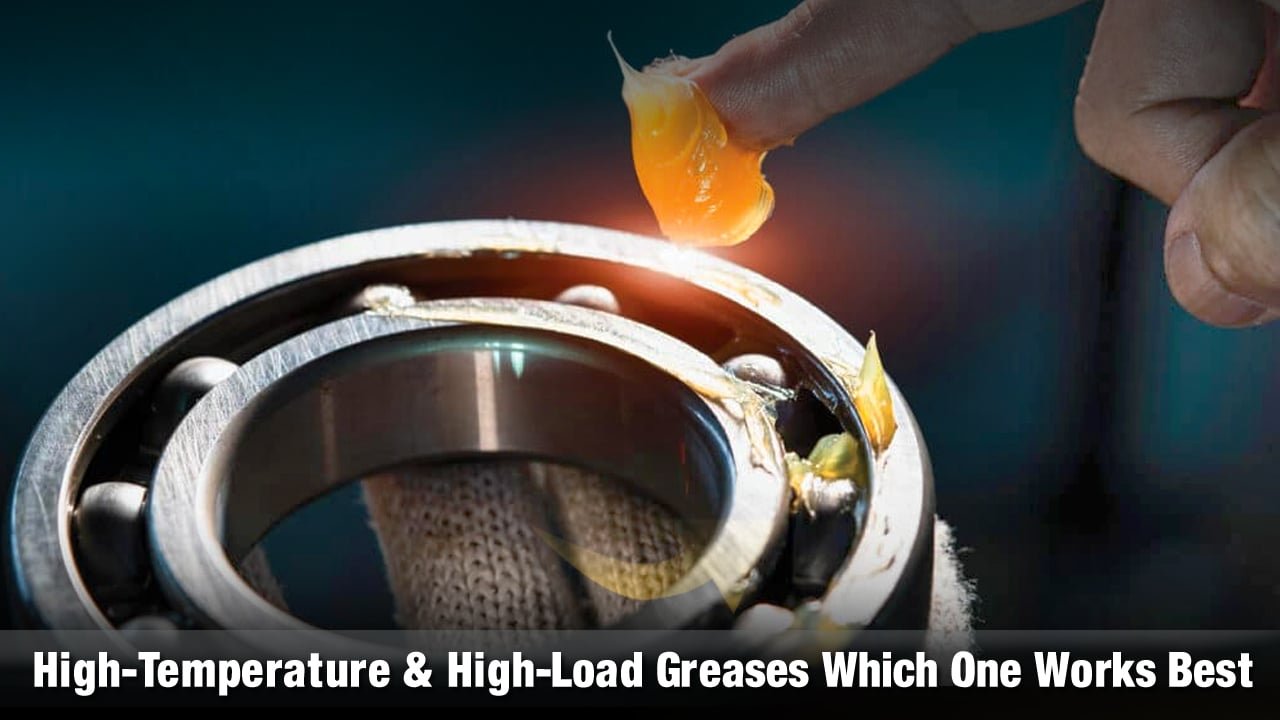
When machines operate under extreme heat or bear intense loads, ordinary grease won’t cut it. That’s where high-temperature and high-load greases come into play—specially formulated to stay stable, protect components, and prevent breakdowns in the harshest conditions. However, with numerous options available on the market, selecting the right one can be a challenging task.
From steel mills and electric motors to ovens and mining equipment, each application has different demands. This guide breaks down what makes these greases work, how to pick the right one, and what factors truly matter when performance is non-negotiable.
Understanding High-Temperature Grease
“High-temperature” doesn’t mean one specific temperature—it varies depending on the application. For instance, steel mill bearings may operate at 149°C (300°F), while drying ovens can reach temperatures of up to 204°C (400°F). Both are considered high-temperature operations.
High-temperature greases are specially designed using a mix of base oils, thickeners, and additives. The cost of grease usually increases with its temperature handling capacity. The formula of the grease determines how well it handles heat, its viscosity, stability, and overall performance.
Even the best high-temperature grease can break down over time. Heat and air exposure cause thermal and oxidative damage, reducing grease life. That’s why regular lubrication is recommended to keep machines running smoothly.
Choosing the proper high-temp grease involves considering the right base oil, the best thickener, and special additives. This careful balance enables the grease to perform effectively under extreme heat without breaking down.
Selecting the Right High-Temperature Grease
Choosing the best high-temperature grease starts with asking the right questions. Here’s what to consider:
- What’s the ambient temperature where the equipment runs? Can you check the exact temperature of the part that needs grease?
- Is the equipment’s maximum temperature steady (continuous) or just once in a while (intermittent)?
- Does the machine go through heating and cooling cycles when it turns on and off?
- Is the grease strong enough to handle the speed and load of the equipment?
- Are there dust, moisture, or chemicals in the air that could affect the grease?
- What base oil type and viscosity (thickness) are best for your machine?
- Which thickener works well with your base oil and the high heat it faces?
- What additives are required to enhance the grease’s performance under pressure?
- How often should you reapply grease, and does that match your equipment’s schedule?
By answering these questions, you can select a reliable, long-lasting, high-temperature grease that keeps your equipment running smoothly, even in extreme heat.
High-Temperature Grease Compatibility
Before choosing a high-temperature grease, it’s essential to ensure it’s compatible with the existing grease. Mixing greases that don’t work well together can lead to poor performance, chemical imbalance, and damage to your equipment.
It’s always better to check compatibility before applying new grease, especially under high-heat conditions. If greases are not compatible, problems may not be apparent until after exposure to high temperatures. One way to resolve this issue is to flush out the old grease during regular relubrication intervals until the problem is resolved.
How to Check Grease Compatibility:
- Use a Compatibility Chart: Each grease type usually comes with a chart that shows which thickener types can be safely mixed.
- Perform Grease Testing: Mix small amounts of the old and new greases in ratios such as 10:90, 50:50, and 90:10. Then heat them to the expected working temperature. Afterward, check for changes in consistency, wear resistance, and other unusual effects.
- Check Key Properties: If the mixed grease gets too soft, melts easily, or loses its protective performance, it’s not compatible.
Always select a compatible high-temperature grease to protect your equipment and ensure it operates at its optimal performance.
How Base Oil Affects Grease Performance at High Temperatures
The way grease performs under high heat depends mainly on the base oil used in its formulation. Base oils with strong heat resistance and stability help grease work better and last longer in extreme temperatures.
Synthetic base oils, such as polyalphaolefins (PAOs) or esters, are ideal for high-temperature conditions. They resist breaking down and retain their protective qualities even when subjected to very high temperatures.
Here are a few key factors to consider:
- Viscosity Index (VI): A higher VI (above 120) indicates that the oil maintains its viscosity better across a wide range of temperatures. This helps maintain proper lubrication in high temperatures.
- Flash Point: Synthetic oils with a flash point over 220°C are safer and less likely to evaporate or break down due to heat.
- Oxidation Stability: Oils that resist oxidation help the grease last longer by slowing down chemical breakdown during high-temperature use.
- Thermal Stability: When temperatures exceed 150°C, synthetic base oils outperform mineral oils. They stay stable and don’t degrade easily.
Choosing the right base oil means better protection, longer grease life, and reliable performance—even in extreme heat. That’s why selecting the right base oil is highly recommended when working with high-temperature greases.
Types of Grease and Their Uses
There are many types of grease, each made for different jobs. The base oil, thickener, and additives decide how the grease performs. Here are the most common types:
Calcium Grease
Calcium grease is one of the oldest types of grease. It offers excellent water resistance, good rust protection, and strong stability. It works best at low temperatures and is used in marine, automotive, industrial, and farming equipment.
Lithium Grease
Lithium grease is a versatile, multi-purpose grease renowned for its exceptional durability and high performance. It protects against heat, pressure, rust, and wear. It’s used in cars, gardening tools, machines, homes, and heavy-duty metal-to-metal parts.
Aluminum Complex Grease
This grease can withstand extremely high temperatures and provides excellent water resistance, rust prevention, and shear stability. It’s often used in the food industry, but also works well in automotive, steel plants, construction, and agriculture.
Barium Complex Grease
Barium grease is a high-performance lubricant. It’s strong under heavy loads, high speeds, and hot conditions. It also resists chemicals, water, and oxidation. It’s used in aerospace, marine, manufacturing, and heavy industry.
Bentonite (Clay) Grease
Also known as non-melting grease, bentonite grease doesn’t have a melting point. It withstands temperature changes, heavy wear, and water. It’s ideal for demanding applications in steel plants, mining, ceramics, and construction.
Polyurea Grease
Polyurea grease is popular because it lasts long and works well in high temperatures. It’s resistant to water, rust, and oxidation. This grease is used in electric motors, steel plants, and other long-life applications.
Sodium Grease
Sodium grease has a high dropping point and good lubrication and rust protection. But it doesn’t resist water well. It’s primarily used in rolling contact bearings and sometimes mixed with other greases to improve performance.
These greases can be labeled as multi-purpose (MP), extreme pressure (EP), marine, automotive, industrial, or specialty greases, depending on their composition and intended use.
Factors to Consider When Choosing the Right Grease
Selecting the proper grease for your equipment is crucial to ensure long-lasting protection and optimal performance. Before you buy, make sure to consider the following:
Base Oil
The base oil is the central part of every grease. It affects how the grease performs in terms of heat resistance, protection, and stability. The most common types are:
- Mineral oils – suitable for general use.
- Synthetic Oils – best for high-performance, high-temperature, or extreme environments.
- Vegetable Oils – used for special eco-friendly or food-safe applications.
Additives
Additives are chemicals that enhance the performance of grease. They help protect against:
- Extreme pressure
- Rust, corrosion, and oxidation
- Wear and tear
- Other additives include polymers to enhance stickiness and dyes to impart the grease its color.
Thickener
The thickener holds the base oil and additives together, giving grease its structure. Common thickeners include:
- Soap-Based Types: lithium, calcium, aluminum, sodium, and barium
- Non-Soap Types: clay (bentone) and polyurea
- Choosing the right thickener helps the grease stay in place and perform under heat or pressure.
Consistency (NLGI Grade)
Consistency tells you how thick or soft the grease is. The National Lubricating Grease Institute (NLGI) rates grease from 000 to 6:
- 000 = fluid (very runny)
- 0–1 = soft
- 2 = standard (most common)
- 3–6 = firm to very hard
- Pick a consistency that matches your equipment’s needs.
Viscosity
Viscosity measures the thickness of the base oil.
- High viscosity = better for heavy loads and slow speeds
- Low viscosity = better for fast-moving parts
Considering these key factors helps you choose the proper grease for longer equipment life and better protection in any condition.
A Bearing Engineer’s Insight into Industrial Lubricating Oils
Understanding how industrial lubricating oils behave under various temperature conditions is crucial for protecting bearings and extending equipment life. Here’s how temperature extremes can affect performance:
High Temperature Effects
- Grease Breakdown: At high temperatures, grease oxidizes faster, forming sludge and varnish. The base oil separates from the thickener, reducing lubrication effectiveness. Additives such as anti-wear and EP agents degrade, weakening their protective effect.
- Increased Oil Evaporation: Mineral-based oils are more liable to evaporation under heat. This evaporation causes bearings to run dry, leading to metal-to-metal contact and accelerated wear.
- Thinner Lubrication Film: As heat rises, the viscosity of oil drops. A thinner oil film forms, reducing hydrodynamic protection and increasing surface friction and wear.
- Reduced Bearing Life: Higher temperatures speed up wear, fatigue, and potential seizure. A general rule: for every 10°C above 70°C, grease life is cut in half.
Low Temperature Effects
- Grease Thickening: In cold environments, grease becomes stiff or solid. This increases startup torque and places extra stress on bearings.
- Poor Lubricant Flow: Cold grease may not flow into critical bearing areas. Starvation of the contact zone leads to boundary lubrication, causing wear and damage.
- Delayed Lubrication at Startup: When starting in low temperatures, it takes time for the grease to soften and flow. Bearings may run dry momentarily, resulting in micropitting and early failure.
Temperature Cycling Effects
- Pumping & Channeling: Frequent temperature changes cause expansion and contraction. This action can pump grease out of the bearing, leaving dry spots and cavities.
- Condensation Issues: During cooling, condensation can occur inside the bearing. Moisture contamination weakens the lubricant film, increasing the risk of corrosion.
Tips for Using High-Temperature Grease
- Measure Operating Temperature: Use contact or infrared sensors to check the actual temperature. This helps keep grease and bearings within a safe range, preventing damage.
- Don’t Over-Grease: Too much grease can trap heat and attract dirt, causing wear and overheating. Always use the right amount for smooth operation.
- Set Proper Relubrication Intervals: Lubricate based on the grease’s longevity. Too often, waste grease; too little causes damage. Find a good balance to reduce costs and downtime.
- Check Grease Compatibility: Before switching greases, test if they’re compatible. Mixing different types can cause breakdowns and equipment issues.
Final Takeaways
Choosing the proper grease involves considering key factors such as base oil type, additives, thickeners, viscosity, and consistency. For high-temperature and heavy-load applications, synthetic greases with robust additive packages provide enhanced protection and performance.
The proper grease reduces wear, extends equipment life, and cuts maintenance costs. A small choice can make a big difference in keeping your machinery running smoothly.
FAQs
Q1: What grease works well in high heat and moderate loads?
Lithium-based grease is recommended. It handles high temperatures and moderate loads very well. It adheres to metal, resists water, and remains stable in harsh conditions, making it ideal for use on cars and industrial machines.
Q2: What makes a heavy-duty grease suitable for moderate loads and high temperatures?
It requires a potent, thickening agent such as a lithium complex or calcium sulfonate, along with a heat-resistant base oil like PAO or an ester. Additives for wear, oxidation, and corrosion help too. This mix keeps the grease stable, sticky, and protective even under heat and pressure.

Editor-at-Large
A passionate writer in the lubricant industry, Awais Iqbal has been covering oils, greases, and industrial fluids since the start of his career. At 25, he’s already written for blogs, catalogs, and brand guides across the UAE. Awais’s insights help companies connect with their audience, and his clear, helpful writing style is trusted by brands in the region.


